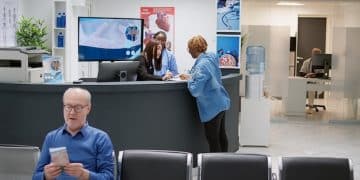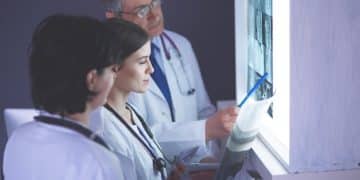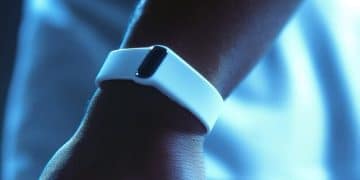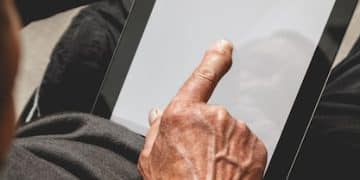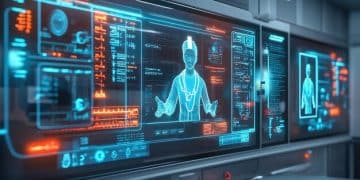The Future of Nursing: Tech’s Impact on US Patient Care
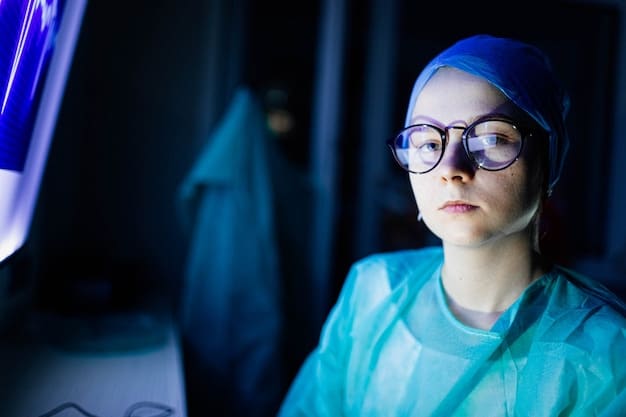
The Future of Nursing: How Technology is Empowering Nurses and Improving Patient Care in the US is being profoundly shaped by innovations, from AI-powered diagnostics to telehealth and wearable devices, which enhance efficiency, elevate patient safety, and expand accessibility to care across the nation.
The landscape of healthcare is in constant flux, and at its heart tirelessly works the nursing profession. In the United States, as the demand for efficient and accessible patient care intensifies, so too does the integration of advanced tools. This article delves into The Future of Nursing: How Technology is Empowering Nurses and Improving Patient Care in the US, exploring the transformative role of innovation in this vital field.
The Digital Renaissance of Nursing: An Overview
The nursing profession, traditionally steeped in hands-on care, is experiencing a profound digital renaissance. This transformation is not merely about introducing new gadgets but fundamentally reshaping how nurses interact with patients, manage information, and practice their skills. The objective is clear: to enhance efficiency, reduce errors, and ultimately elevate the standard of patient care across the US healthcare system.
Nurses today operate in a complex ecosystem where data, precision, and rapid communication are paramount. Technology serves as an invaluable ally, enabling them to navigate these challenges more effectively. From sophisticated electronic health records to intelligent monitoring devices, the toolkit available to contemporary nurses is expanding at an unprecedented rate, demanding continuous adaptation and learning.
Empowering Nurses through Digital Tools
The push for technological integration in nursing is not just an administrative mandate; it is a direct response to the evolving needs of patients and the increasing complexities of medical treatments. Digital tools empower nurses by:
- Automating Routine Tasks: Freeing up valuable time for direct patient interaction and critical thinking.
- Enhancing Data Access: Providing immediate access to comprehensive patient histories, lab results, and medication lists.
- Improving Communication: Fostering seamless collaboration between healthcare providers, regardless of their location.
Improving Patient Care through Smart Solutions
The direct beneficiaries of this technological shift are the patients themselves. The ability of nurses to leverage technology translates into more accurate diagnoses, personalized treatment plans, and proactive interventions. This shift marks a move from reactive care to a more predictive and preventive approach, ultimately leading to better health outcomes and a more positive patient experience.
As we delve deeper into specific technological advancements, it becomes evident that each innovation, no matter how small, contributes significantly to advancing the nursing profession. This holistic approach to integrating technology promises a future where nursing is not just efficient but also more empathetic and effective, redefining the boundaries of what is possible in patient care.
Electronic Health Records (EHRs) and Data Analytics
Electronic Health Records (EHRs) have fundamentally transformed how medical information is managed and accessed. No longer confined to paper charts and bulky files, patient data is now digitized, centralized, and instantly available to authorized healthcare professionals. This shift has had a profound impact on nursing practice, improving efficiency, accuracy, and coordination of care across the US healthcare landscape.
For nurses, EHRs represent a significant leap forward in workflow management. The ability to quickly retrieve a patient’s complete medical history, including past diagnoses, treatments, medications, and allergies, streamlines the assessment process. This immediate access to comprehensive information allows nurses to make more informed decisions rapidly, reducing the time spent on administrative tasks and increasing their focus on direct patient care.
Benefits of EHRs for Nurses and Patients
The advantages of widespread EHR adoption extend beyond mere convenience:
- Enhanced Patient Safety: By providing real-time alerts for drug interactions or allergies, EHRs prevent potential medical errors.
- Improved Care Coordination: All members of a patient’s healthcare team can access the same up-to-date information, facilitating seamless transitions of care between departments or facilities.
- Reduced Duplication of Tests: With a complete history available, unnecessary or redundant diagnostic tests can be avoided, saving resources and patient discomfort.
The Power of Data Analytics in Nursing
Beyond simply storing data, EHRs are now powerful tools for data analytics. This involves processing vast amounts of patient information to identify patterns, predict outcomes, and inform evidence-based practice. For nursing, data analytics offers several transformative applications:
By analyzing aggregated patient data, nurses and healthcare systems can identify trends in disease prevalence, evaluate the effectiveness of different interventions, and even predict potential outbreaks. This proactive approach allows for better resource allocation and preventative measures, moving healthcare from reactive crisis management to predictive wellness planning.
For instance, data analytics can highlight which patient demographics are most susceptible to certain conditions or which nursing interventions yield the best results for specific diagnoses. This information helps shape clinical guidelines and educational initiatives, ensuring that nursing care is consistently aligned with the most effective and efficient practices. The integration of EHRs with advanced analytical capabilities is not just changing how nurses work; it is redefining the very essence of patient care, making it more data-driven, precise, and personalized.
Telehealth and Remote Patient Monitoring
The advent of telehealth has revolutionized healthcare delivery, particularly in the realm of nursing. Originally conceived as a way to provide care in remote or underserved areas, telehealth has rapidly expanded, becoming an indispensable tool for routine check-ups, chronic disease management, and mental health support. For nurses, telehealth platforms facilitate direct patient consultations through video calls, phone calls, and secure messaging, eliminating geographical barriers and significantly improving access to care across the United States.
This virtual mode of interaction empowers nurses to perform initial assessments, monitor patient progress, provide health education, and adjust care plans from afar. It has proven especially vital in situations where in-person visits are impractical or limited, such as during public health crises or for patients with mobility issues. The flexibility and convenience offered by telehealth enable nurses to manage larger patient panels more efficiently while still delivering personalized attention.
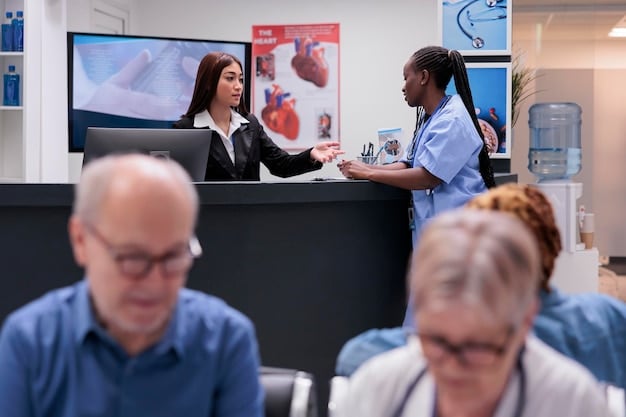
Remote Patient Monitoring (RPM): Bridging the Distance
Complementary to telehealth, Remote Patient Monitoring (RPM) technologies represent another significant leap forward. RPM involves equipping patients with wearable devices or home sensors that continuously collect vital health data, such as blood pressure, glucose levels, heart rate, and oxygen saturation. This data is then transmitted securely to healthcare providers, allowing nurses to track patient health in real-time, even when they are not in a clinical setting.
The implementation of RPM offers numerous benefits:
- Early Detection of Issues: Nurses can identify subtle changes in a patient’s condition that might otherwise go unnoticed, enabling timely intervention and preventing acute exacerbations.
- Improved Chronic Disease Management: For patients with conditions like diabetes, hypertension, or heart failure, RPM provides continuous oversight, helping them stay within target ranges and adhere to treatment plans.
- Reduced Hospital Readmissions: Proactive monitoring and intervention can significantly decrease the likelihood of patients needing to return to the hospital shortly after discharge.
Taken together, telehealth and RPM are transforming the nursing role from one primarily focused on episodic, in-person care to a continuous, proactive, and remote oversight model. This shift not only enhances patient outcomes by ensuring consistent monitoring but also empowers patients to take a more active role in managing their own health, fostering a more collaborative and informed approach to healthcare.
Artificial Intelligence (AI) and Machine Learning in Nursing
Artificial Intelligence (AI) and Machine Learning (ML) are rapidly transitioning from theoretical concepts to practical applications within healthcare, profoundly influencing the future of nursing. These technologies are not designed to replace human caregivers but rather to augment their capabilities, providing advanced insights and automating complex data analysis. In the US, nurses are increasingly leveraging AI and ML tools to enhance diagnostic accuracy, predict patient risks, and optimize their daily workflows, thereby elevating the quality and efficiency of patient care.
The power of AI lies in its ability to process vast datasets at speeds impossible for humans, identifying patterns and correlations that might otherwise remain hidden. For nurses, this translates into more precise and timely information, enabling them to make evidence-based decisions with greater confidence. Whether it’s interpreting complex scans or identifying subtle changes in a patient’s condition, AI acts as an intelligent assistant, refining the diagnostic and monitoring processes.
Predictive Analytics and Risk Assessment
One of the most impactful applications of AI/ML in nursing is predictive analytics. By analyzing historical patient data, including demographics, medical history, lab results, and even social determinants of health, these systems can forecast a patient’s likelihood of developing certain conditions, experiencing complications, or needing readmission. For nurses, this means:
- Proactive Intervention: Identifying at-risk patients early allows nurses to implement preventive measures or intensify monitoring before a crisis occurs.
- Personalized Care Plans: Predictions help tailor interventions to individual patient needs, leading to more effective and targeted care.
- Optimized Resource Allocation: Foreseeing potential surges in demand or specific patient needs enables better planning and deployment of nursing staff and resources.
AI-Powered Diagnostic Support and Workflow Optimization
AI also plays a crucial role in diagnostic support, particularly in fields like radiology and pathology, where it can assist in identifying abnormalities in images or lab results. While the final diagnosis remains with a physician, nurses benefit from earlier detection and clearer insights into a patient’s condition, facilitating quicker initiation of treatment or referral.
Furthermore, AI and ML are being applied to optimize nursing workflows. This includes intelligent scheduling systems that consider patient acuity and nurse expertise, as well as natural language processing (NLP) tools that can extract crucial information from unstructured clinical notes, streamlining documentation and reducing administrative burden. By automating data-heavy tasks and offering advanced analytical support, AI and ML empower nurses to dedicate more time and energy to direct patient interaction, empathy, and critical thinking, reinforcing their indispensable role in a technologically advanced healthcare future.
Wearable Devices and Biosensors
The proliferation of wearable devices and biosensors signifies a new era in health monitoring, moving data collection from episodic clinical encounters to continuous, real-time measurements in everyday life. These sophisticated yet often discreet technologies are providing nurses and healthcare providers with an unprecedented window into a patient’s physiological state, even when they are outside the traditional clinical setting. In the US, the adoption of these devices is rapidly expanding, profoundly empowering nurses and enhancing patient care through continuous, personalized data streams.
From smartwatches tracking heart rates and sleep patterns to patches monitoring glucose levels and activity, these devices collect a wealth of data that can be invaluable for preventative care, chronic disease management, and post-discharge monitoring. For nurses, this means actionable insights that allow for more proactive interventions and truly individualized care plans, moving beyond the limited snapshots provided by infrequent office visits.
Impact on Patient Monitoring and Health Management
The integration of wearable devices and biosensors into nursing practice offers several transformative benefits:
- Continuous Vigilance: Nurses can monitor vital signs, activity levels, and symptom progression remotely and continuously, immediately identifying deviations from baseline.
- Enhanced Patient Engagement: Patients become more involved in their own health due to readily available data and feedback from their devices, fostering self-management and adherence to health goals.
- Early Detection of Deterioration: Subtle changes captured by biosensors can alert nurses to potential health problems before they become critical, leading to timely interventions and improved outcomes.
For example, a patient with congestive heart failure might wear a device that tracks weight and fluid retention, alerting their nurse to signs of worsening condition. Similarly, a diabetic patient wearing a continuous glucose monitor can send real-time data to their nurse, allowing for immediate adjustments to insulin dosages or dietary advice.
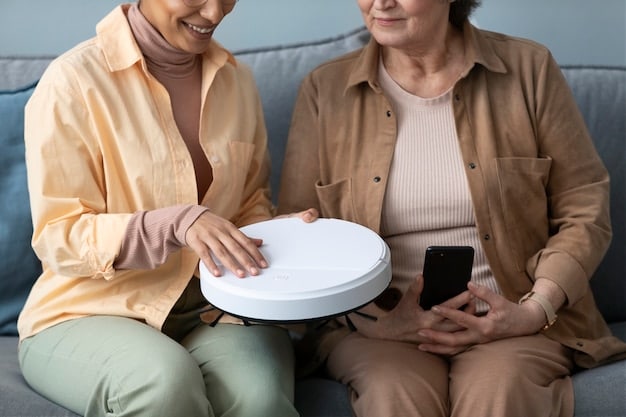
Expanding the Reach of Nursing Care
Beyond individual patient management, the data aggregated from numerous wearable devices can contribute to larger epidemiological studies and public health initiatives. Nurses, as front-line data collectors and interpreters, play a crucial role in leveraging this information for broader health improvements.
The practical application of wearable technology also extends to preventative care. Nurses can guide patients in using these devices for fitness tracking, stress management, and sleep optimization, encouraging healthier lifestyles and reducing the incidence of chronic diseases. By empowering patients with personal health data and providing nurses with continuous, actionable insights, wearable devices and biosensors are not just tools; they are integral components of a more connected, proactive, and personalized future for nursing and patient care in the US.
Robotics and Automation in Clinical Settings
While often associated with manufacturing or complex surgeries, robotics and automation are increasingly finding their place in clinical nursing environments, redefining routine tasks and enhancing patient safety. These technologies are not designed to diminish the human element of nursing but rather to support and extend nurses’ capabilities, allowing them to allocate more time to direct patient interaction, critical thinking, and complex care. In US healthcare settings, robots are taking on roles that range from logistical support to assisting with patient care, thereby optimizing operational efficiency and improving overall patient experience.
The primary aim of integrating robotics into nursing is to alleviate the burden of repetitive, physically demanding, or time-consuming tasks. This frees up nurses to focus on areas where their unique human skills—such as empathy, judgment, and complex problem-solving—are irreplaceable. From medication delivery to patient transport, automated systems are streamlining processes, reducing the potential for human error, and creating a more efficient hospital ecosystem.
Applications of Robotics in Nursing Care
Several types of robots are being deployed in nursing contexts:
- Automated Medication Dispensing Systems: These robots accurately dispense and deliver medications, reducing the risk of errors and ensuring timely administration.
- Logistics and Transport Robots: Known as autonomous mobile robots (AMRs), they transport linens, supplies, lab samples, and even meals throughout hospitals, minimizing the need for nurses to leave patient care areas.
- Telepresence Robots: These robots allow healthcare professionals to conduct virtual rounds or consultations with patients remotely, particularly useful in situations where physical presence is challenging or limited.
An example might be a hospital where an AMR autonomously delivers a patient’s prescribed medication from the pharmacy to their bedside, ensuring accuracy and freeing the nurse to perform a more complex assessment for another patient.
Automation for Enhanced Safety and Efficiency
Beyond “physical” robots, process automation also plays a critical role. This includes automated vital sign monitoring systems that transmit data directly to EHRs, eliminating manual transcription errors, and smart infusion pumps that can be programmed to deliver precise medication doses while alerting nurses to potential issues.
The benefits of these integrations are manifold:
- Reduced Nurse Burnout: By automating mundane or physically strenuous tasks, robots help alleviate workload, contributing to better staff morale and retention.
- Increased Patient Safety: Precision and consistency provided by automated systems minimize human error in medication administration and data recording.
- Optimized Workflow: Efficient logistics and automated data entry allow nurses to spend more time on high-value activities, leading to improved patient outcomes and satisfaction.
As robotics technology continues to advance, its role in supporting the nursing profession will undoubtedly expand, leading to smarter, safer, and more efficient patient care environments across the US. The future sees nurses working hand-in-hand with intelligent machines, each complementing the strengths of the other for a common goal: superior healthcare.
Digital Literacy and Training for Nurses
As technology continues its rapid integration into healthcare, the demand for nurses who are not just clinically skilled but also digitally literate becomes paramount. The sophisticated tools discussed—EHRs, telehealth platforms, AI-powered diagnostics, wearable devices, and robotics—are only as effective as the professionals using them. Therefore, robust and continuous training in digital literacy is not merely a bonus but a fundamental requirement for the modern nursing workforce in the US.
Digital literacy goes beyond basic computer proficiency; it encompasses the ability to effectively navigate complex software, understand data, troubleshoot technical issues, and apply digital tools critically in clinical practice. For nurses, this means being comfortable with new interfaces, interpreting data visualizations, safeguarding patient information in digital environments, and adapting to ever-evolving technological advancements.
Challenges and Opportunities in Digital Training
The rapid pace of technological change presents both challenges and opportunities for nursing education and professional development:
- Curriculum Integration: Nursing schools must integrate comprehensive digital health components into their curricula, preparing future nurses for a tech-driven workplace from day one.
- Continuing Education: Existing nurses require access to ongoing education and training programs that keep them abreast of new technologies and best practices.
- Addressing the Digital Divide: Ensuring equitable access to training and technology for all nurses, regardless of their age, experience, or geographical location, is crucial.
Many healthcare institutions are investing in simulation labs equipped with realistic digital environments, allowing nurses to practice using EHRs, telehealth systems, and even robotic assistants in a safe, controlled setting before applying these skills in patient care scenarios.
Empowering Nurses through Continuous Learning
Investing in digital literacy training offers significant returns:
- Increased Efficiency and Confidence: Well-trained nurses can leverage technology more effectively, reducing frustration and maximizing the benefits of digital tools.
- Enhanced Patient Safety: Proper understanding of digital systems minimizes errors related to data entry, medication administration, or communication breakdowns.
- Career Advancement: Nurses with strong digital skills are better positioned for leadership roles and specialized areas in a technologically evolving healthcare system.
Ultimately, a digitally proficient nursing workforce is a more adaptive, resilient, and effective workforce. By prioritizing continuous learning and providing the necessary resources, healthcare organizations can empower their nurses to not only adopt new technologies but to actively drive innovation, ensuring that patient care in the US remains at the forefront of global healthcare standards. This commitment to digital literacy is foundational to realizing the full potential of technology in the future of nursing.
| Key Technological Advancements | Impact on Nursing & Patient Care |
|---|---|
| 📊 EHRs & Data Analytics | Streamline access to patient data, improve decision-making, and enhance care coordination through predictive insights. |
| telehealth & RPM | Expand access to care, enable remote patient monitoring, and facilitate continuous oversight for chronic conditions. |
| 🤖 AI & Machine Learning | Support diagnostic accuracy, predict patient risks, and optimize workflows, allowing nurses to focus on direct patient interaction. |
| ⌚ Wearables & Biosensors | Provide real-time vital data, facilitate continuous monitoring, and empower patients in their self-management of health. |
Frequently Asked Questions About the Future of Nursing Technology
▼
EHRs enhance patient safety by providing instant access to complete patient medical histories, including allergies and current medications. This real-time data helps nurses identify potential drug interactions, avoid errors, and ensure appropriate care delivery. The system also flags critical information, reducing adverse events.
▼
Telehealth complements traditional in-person care rather than fully replacing it. While excellent for routine consultations, remote monitoring, and follow-ups, certain nursing interventions require a physical presence. The future involves a hybrid model where telehealth handles what it can efficiently, reserving in-person care for critical needs.
▼
AI empowers nurses by automating data analysis, providing predictive insights into patient deterioration, and assisting with clinical decision-making. It helps in identifying at-risk patients, optimizing workflow, and reducing administrative tasks, allowing nurses more time for direct patient interaction and complex problem-solving. This collaboration enhances efficiency.
▼
Wearable devices provide nurses with continuous, real-time data on patients’ vital signs and activity levels. This enables proactive monitoring, early detection of health changes, and personalized care plans, especially for chronic disease management. They extend the reach of nursing care beyond the clinical setting, fostering better patient outcomes.
▼
Essential training for nurses includes comprehensive digital literacy, hands-on experience with specific EHRs and telehealth platforms, and understanding of data privacy. Continuous professional development, including workshops and certifications, ensures nurses remain proficient with evolving technologies, critical for providing high-quality, tech-integrated patient care.
Conclusion
The journey into The Future of Nursing: How Technology is Empowering Nurses and Improving Patient Care in the US reveals a landscape continuously reshaped by innovation. From the foundational shift ushered in by EHRs and the expansive reach of telehealth to the predictive power of AI, the continuous insights from wearable devices, and the efficiency brought by robotics, technology is not just an add-on but an intrinsic part of modern nursing. These advancements collectively empower nurses to deliver more precise, efficient, and patient-centered care, directly contributing to improved health outcomes across the nation. As the healthcare ecosystem evolves, so too will the tools and skills required, beckoning a future where technology and human touch harmoniously converge for the ultimate benefit of patient well-being.

